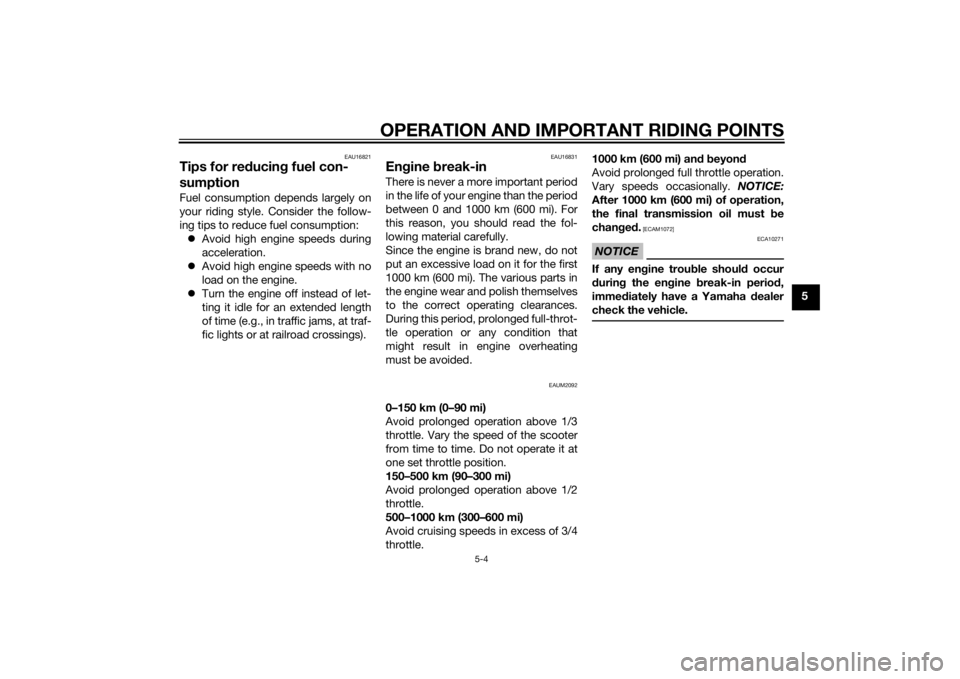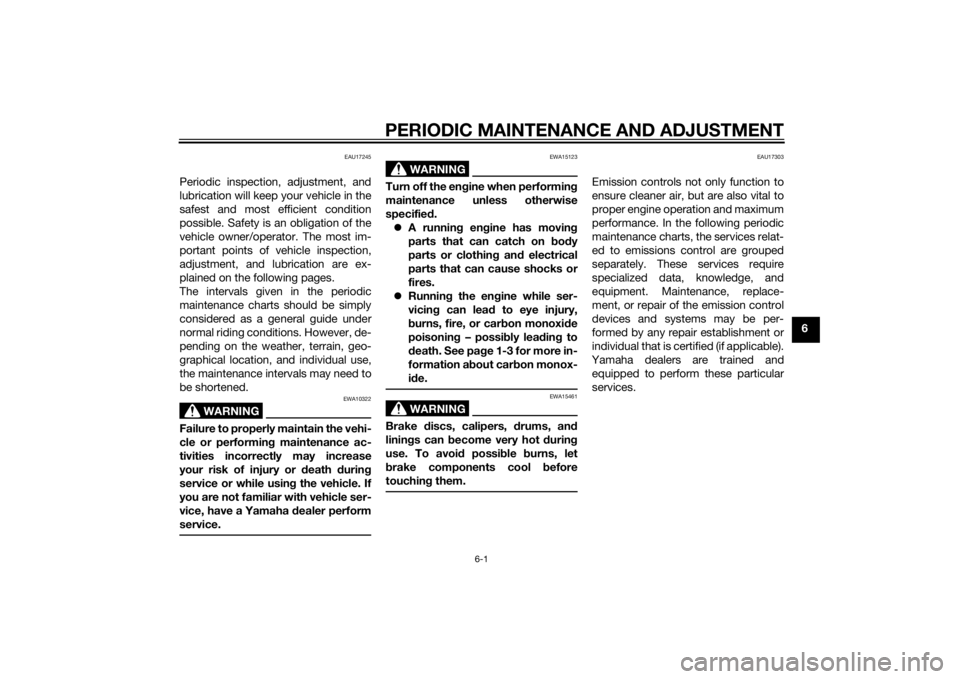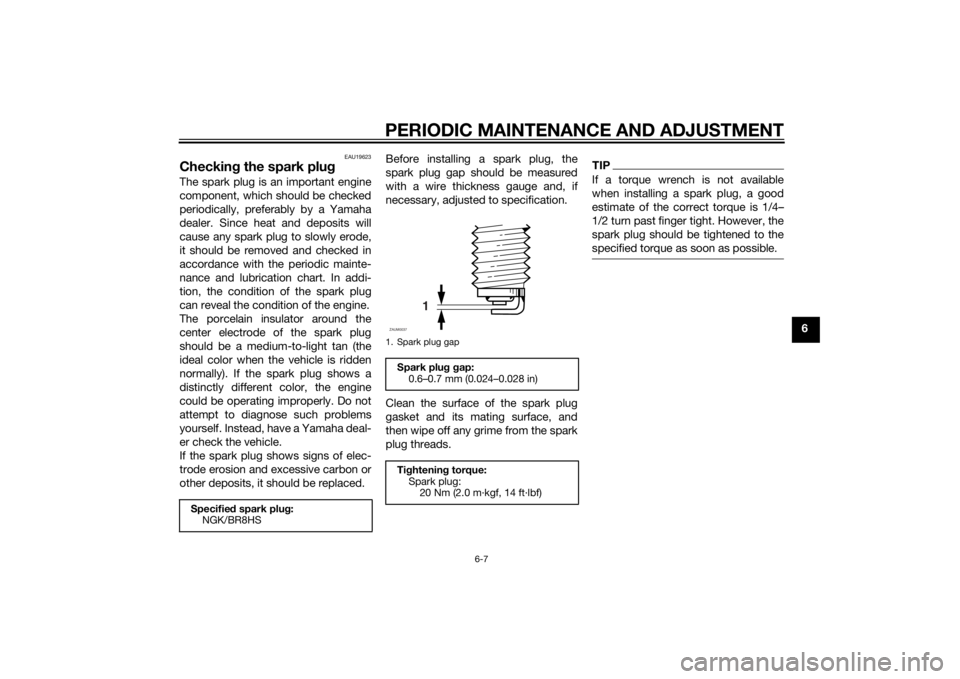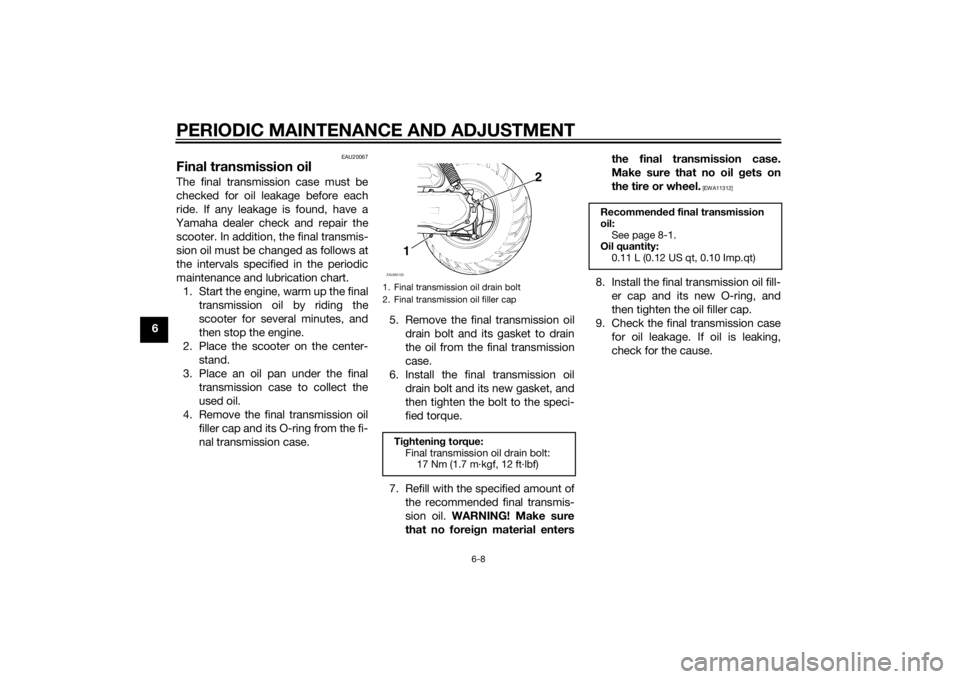YAMAHA SLIDER 50 2014 Owner's Guide
Manufacturer: YAMAHA, Model Year: 2014, Model line: SLIDER 50, Model: YAMAHA SLIDER 50 2014Pages: 68, PDF Size: 2.03 MB
Page 31 of 68

OPERATION AND IMPORTANT RIDING POINTS
5-4
5
EAU16821
Tips for reducing fuel con-
sumptionFuel consumption depends largely on
your riding style. Consider the follow-
ing tips to reduce fuel consumption:
Avoid high engine speeds during
acceleration.
Avoid high engine speeds with no
load on the engine.
Turn the engine off instead of let-
ting it idle for an extended length
of time (e.g., in traffic jams, at traf-
fic lights or at railroad crossings).
EAU16831
Engine break-inThere is never a more important period
in the life of your engine than the period
between 0 and 1000 km (600 mi). For
this reason, you should read the fol-
lowing material carefully.
Since the engine is brand new, do not
put an excessive load on it for the first
1000 km (600 mi). The various parts in
the engine wear and polish themselves
to the correct operating clearances.
During this period, prolonged full-throt-
tle operation or any condition that
might result in engine overheating
must be avoided.
EAUM2092
0–150 km (0–90 mi)
Avoid prolonged operation above 1/3
throttle. Vary the speed of the scooter
from time to time. Do not operate it at
one set throttle position.
150–500 km (90–300 mi)
Avoid prolonged operation above 1/2
throttle.
500–1000 km (300–600 mi)
Avoid cruising speeds in excess of 3/4
throttle.1000 km (600 mi) and beyond
Avoid prolonged full throttle operation.
Vary speeds occasionally. NOTICE:
After 1000 km (600 mi) of operation,
the final transmission oil must be
changed.
[ECAM1072]
NOTICE
ECA10271
If any engine trouble should occur
during the engine break-in period,
immediately have a Yamaha dealer
check the vehicle.
U1S0E2E0.book Page 4 Thursday, July 25, 2013 6:53 PM
Page 32 of 68

OPERATION AND IMPORTANT RIDING POINTS
5-5
5
EAU17214
ParkingWhen parking, stop the engine, and
then remove the key from the main
switch.
WARNING
EWA10312
Since the engine and exhaust
system can become very hot,
park in a place where pedestri-
ans or children are not likely to
touch them and be burned.
Do not park on a slope or on soft
ground, otherwise the vehicle
may overturn, increasing the
risk of a fuel leak and fire.
Do not park near grass or other
flammable materials which
might catch fire.
U1S0E2E0.book Page 5 Thursday, July 25, 2013 6:53 PM
Page 33 of 68

PERIODIC MAINTENANCE AND ADJUSTMENT
6-1
6
EAU17245
Periodic inspection, adjustment, and
lubrication will keep your vehicle in the
safest and most efficient condition
possible. Safety is an obligation of the
vehicle owner/operator. The most im-
portant points of vehicle inspection,
adjustment, and lubrication are ex-
plained on the following pages.
The intervals given in the periodic
maintenance charts should be simply
considered as a general guide under
normal riding conditions. However, de-
pending on the weather, terrain, geo-
graphical location, and individual use,
the maintenance intervals may need to
be shortened.
WARNING
EWA10322
Failure to properly maintain the vehi-
cle or performing maintenance ac-
tivities incorrectly may increase
your risk of injury or death during
service or while using the vehicle. If
you are not familiar with vehicle ser-
vice, have a Yamaha dealer perform
service.
WARNING
EWA15123
Turn off the engine when performing
maintenance unless otherwise
specified.
A running engine has moving
parts that can catch on body
parts or clothing and electrical
parts that can cause shocks or
fires.
Running the engine while ser-
vicing can lead to eye injury,
burns, fire, or carbon monoxide
poisoning – possibly leading to
death. See page 1-3 for more in-
formation about carbon monox-
ide.
WARNING
EWA15461
Brake discs, calipers, drums, and
linings can become very hot during
use. To avoid possible burns, let
brake components cool before
touching them.
EAU17303
Emission controls not only function to
ensure cleaner air, but are also vital to
proper engine operation and maximum
performance. In the following periodic
maintenance charts, the services relat-
ed to emissions control are grouped
separately. These services require
specialized data, knowledge, and
equipment. Maintenance, replace-
ment, or repair of the emission control
devices and systems may be per-
formed by any repair establishment or
individual that is certified (if applicable).
Yamaha dealers are trained and
equipped to perform these particular
services.
U1S0E2E0.book Page 1 Thursday, July 25, 2013 6:53 PM
Page 34 of 68

PERIODIC MAINTENANCE AND ADJUSTMENT
6-2
6
EAU46872
TIPThe annual checks must be performed every year, except if a kilometer-based maintenance, or for the UK, a
mileage-based maintenance, is performed instead.
From 30000 km (17500 mi), repeat the maintenance intervals starting from 6000 km (3500 mi).
Items marked with an asterisk should be performed by a Yamaha dealer as they require special tools, data and tech-
nical skills.
EAU46921
Periodic maintenance chart for the emission control systemNO. ITEM CHECK OR MAINTENANCE JOBODOMETER READING
ANNUAL
CHECK 1000 km
(600 mi)6000 km
(3500 mi)12000 km
(7000 mi)18000 km
(10500 mi)24000 km
(14000 mi)
1*Fuel line• Check fuel and vacuum hoses for
cracks or damage.√√√√√
2Spark plug• Replace.√√√√√
3*Carburetor• Adjust engine idling speed.√√√√√√
4*Air induction sys-
tem• Check the air cut-off valve, reed
valve, and hose for damage.
• Replace any damaged parts if
necessary.√√√√√
U1S0E2E0.book Page 2 Thursday, July 25, 2013 6:53 PM
Page 35 of 68

PERIODIC MAINTENANCE AND ADJUSTMENT
6-3
6
EAU1771A
General maintenance and lubrication chartNO. ITEM CHECK OR MAINTENANCE JOBODOMETER READING
ANNUAL
CHECK 1000 km
(600 mi)6000 km
(3500 mi)12000 km
(7000 mi)18000 km
(10500 mi)24000 km
(14000 mi)
1 Air filter element• Clean.√√
•Replace.√√
2*Battery• Check electrolyte level and spe-
cific gravity.
• Make sure that the breather hose
is properly routed.√√√√√
3*Front brake• Check operation, fluid level and
vehicle for fluid leakage.√√√√√√
• Replace brake pads. Whenever worn to the limit
4*Rear brake• Check operation and adjust brake
lever free play.√√√√√√
• Replace brake shoes. Whenever worn to the limit
5*Brake hose• Check for cracks or damage.
• Check for correct routing and
clamping.√√√√√
• Replace. Every 4 years
6*Brake fluid• Replace. Every 2 years
7*Wheels• Check runout and for damage.√√√√
8*Tires• Check tread depth and for dam-
age.
• Replace if necessary.
• Check air pressure.
• Correct if necessary.√√√√√
U1S0E2E0.book Page 3 Thursday, July 25, 2013 6:53 PM
Page 36 of 68

PERIODIC MAINTENANCE AND ADJUSTMENT
6-4
6
9*Wheel bearings• Check bearing for looseness or
damage.√√√√
10*Steering bearings• Check bearing play and steering
for roughness.√√√√√
• Lubricate with lithium-soap-
based grease.Every 24000 km (14000 mi)
11*Chassis fasteners• Make sure that all nuts, bolts and
screws are properly tightened.√√√√√
12Front brake lever
pivot shaft• Lubricate with silicone grease.√√√√√
13Rear brake lever
pivot shaft• Lubricate with lithium-soap-
based grease.√√√√√
14 Centerstand• Check operation.
• Lubricate.√√√√√
15*Front fork• Check operation and for oil leak-
age.√√√√
16*Shock absorber as-
sembly• Check operation and shock ab-
sorber for oil leakage.√√√√
17*Autolube pump• Check operation.
• Bleed if necessary.√√√√
18Final transmission
oil• Check vehicle for oil leakage.√√ √
• Change.√√√
19*V-belt• Replace. Every 10000 km (6000 mi)
20*Front and rear
brake switches• Check operation.√√√√√√ NO. ITEM CHECK OR MAINTENANCE JOB
ODOMETER READING
ANNUAL
CHECK 1000 km
(600 mi)6000 km
(3500 mi)12000 km
(7000 mi)18000 km
(10500 mi)24000 km
(14000 mi)
U1S0E2E0.book Page 4 Thursday, July 25, 2013 6:53 PM
Page 37 of 68

PERIODIC MAINTENANCE AND ADJUSTMENT
6-5
6
EAUM2071
TIPThe air filter needs more frequent service if you are riding in unusually wet or dusty areas.
Hydraulic brake service
• Regularly check and, if necessary, correct the brake fluid level.
• Every two years change the brake fluid.
• Replace the brake hoses every four years and if cracked or damaged.21Moving parts and
cables• Lubricate.√√√√√
22*Throttle grip• Check operation.
• Check throttle grip free play, and
adjust if necessary.
• Lubricate cable and grip housing.√√√√√
23*Lights, signals and
switches• Check operation.
• Adjust headlight beam.√√√√√√ NO. ITEM CHECK OR MAINTENANCE JOBODOMETER READING
ANNUAL
CHECK 1000 km
(600 mi)6000 km
(3500 mi)12000 km
(7000 mi)18000 km
(10500 mi)24000 km
(14000 mi)
U1S0E2E0.book Page 5 Thursday, July 25, 2013 6:53 PM
Page 38 of 68

PERIODIC MAINTENANCE AND ADJUSTMENT
6-6
6
EAU18743
Removing and installing the
cowling and panelThe cowling and panel shown need to
be removed to perform some of the
maintenance jobs described in this
chapter. Refer to this section each time
the cowling or panel needs to be re-
moved and installed.
EAU18791
Cowling A
To remove the cowlingRemove the screws, and then take the
cowling off.To install the cowling
Place the cowling in the original posi-
tion, and then install the screws.
EAU19211
Panel A
To remove the panelRemove the screws, and then take the
panel off.To install the panel
Place the panel in the original position,
and then install the screws.
1. Cowling A
2. Panel A
1
2
ZAUM0605
1. Screw
1
1
ZAUM0606
1. Panel A
2. Screw
1
2
ZAUM0607
U1S0E2E0.book Page 6 Thursday, July 25, 2013 6:53 PM
Page 39 of 68

PERIODIC MAINTENANCE AND ADJUSTMENT
6-7
6
EAU19623
Checking the spark plugThe spark plug is an important engine
component, which should be checked
periodically, preferably by a Yamaha
dealer. Since heat and deposits will
cause any spark plug to slowly erode,
it should be removed and checked in
accordance with the periodic mainte-
nance and lubrication chart. In addi-
tion, the condition of the spark plug
can reveal the condition of the engine.
The porcelain insulator around the
center electrode of the spark plug
should be a medium-to-light tan (the
ideal color when the vehicle is ridden
normally). If the spark plug shows a
distinctly different color, the engine
could be operating improperly. Do not
attempt to diagnose such problems
yourself. Instead, have a Yamaha deal-
er check the vehicle.
If the spark plug shows signs of elec-
trode erosion and excessive carbon or
other deposits, it should be replaced.Before installing a spark plug, the
spark plug gap should be measured
with a wire thickness gauge and, if
necessary, adjusted to specification.
Clean the surface of the spark plug
gasket and its mating surface, and
then wipe off any grime from the spark
plug threads.
TIPIf a torque wrench is not available
when installing a spark plug, a good
estimate of the correct torque is 1/4…
1/2 turn past finger tight. However, the
spark plug should be tightened to the
specified torque as soon as possible.
Specified spark plug:
NGK/BR8HS
1. Spark plug gap
Spark plug gap:
0.6–0.7 mm (0.024–0.028 in)
Tightening torque:
Spark plug:
20 Nm (2.0 m·kgf, 14 ft·lbf)
1
ZAUM0037
U1S0E2E0.book Page 7 Thursday, July 25, 2013 6:53 PM
Page 40 of 68

PERIODIC MAINTENANCE AND ADJUSTMENT
6-8
6
EAU20067
Final transmission oilThe final transmission case must be
checked for oil leakage before each
ride. If any leakage is found, have a
Yamaha dealer check and repair the
scooter. In addition, the final transmis-
sion oil must be changed as follows at
the intervals specified in the periodic
maintenance and lubrication chart.
1. Start the engine, warm up the final
transmission oil by riding the
scooter for several minutes, and
then stop the engine.
2. Place the scooter on the center-
stand.
3. Place an oil pan under the final
transmission case to collect the
used oil.
4. Remove the final transmission oil
filler cap and its O-ring from the fi-
nal transmission case.5. Remove the final transmission oil
drain bolt and its gasket to drain
the oil from the final transmission
case.
6. Install the final transmission oil
drain bolt and its new gasket, and
then tighten the bolt to the speci-
fied torque.
7. Refill with the specified amount of
the recommended final transmis-
sion oil. WARNING! Make sure
that no foreign material entersthe final transmission case.
Make sure that no oil gets on
the tire or wheel.
[EWA11312]
8. Install the final transmission oil fill-
er cap and its new O-ring, and
then tighten the oil filler cap.
9. Check the final transmission case
for oil leakage. If oil is leaking,
check for the cause.
1. Final transmission oil drain bolt
2. Final transmission oil filler capTightening torque:
Final transmission oil drain bolt:
17 Nm (1.7 m·kgf, 12 ft·lbf)12
ZAUM0153
Recommended final transmission
oil:
See page 8-1.
Oil quantity:
0.11 L (0.12 US qt, 0.10 Imp.qt)
U1S0E2E0.book Page 8 Thursday, July 25, 2013 6:53 PM